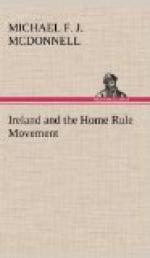The seventh article of the Act of Union, which comprised the financial proposals of the Act, has been summarised as follows in the report of a Royal Commission, to which we shall have occasion to refer later:—
“Ireland and Great Britain had entered into legislative partnership on the clear understanding that they were still, for the purposes of taxation, to be regarded as separate and distinct entities. Ireland was to contribute to the common expenditure in proportion to her resources, so far as the same could be ascertained, and even after the imposition of indiscriminate taxation, if circumstances permitted, she might claim special exemptions and abatements.”
We have seen how the taxation of Ireland at the time of the Union was three millions. Five years later the figure had risen to four millions, and it went on increasing at this rate until in 1815 it amounted to no less than six and a half millions, having more than doubled in amount in a space of fifteen years, while during the same time the National Debt had risen from four and a half to ten and a half millions.
To understand the significance of these figures it must be realised that the Napoleonic war was in progress, and that the supply, on the part of Ireland, of provisions at enhanced war prices was the only means by which she was able to cope with her increasing liabilities. The conclusion of the war and the consequent fall in prices accelerated a crisis in Irish finance. Even in the years of plenty not more than one-half of what the Act of Union proposed could be squeezed out of the country, and the balance, which was added to her debt, raised the ratio which it bore to that of Great Britain from the proportion of 1 to 15-1/2 in 1800 to that of 2 to 17 in 1817. One would have thought that such an increase of debt would have made Ireland less fitted to bear equal taxation with Great Britain, but the statesmen of the day thought otherwise, and in 1817 the Exchequers were amalgamated. Even then the fiscal systems of the two countries were not in all respects assimilated, though in regard to some taxes an equalisation was effected, as, for example, in the case of tobacco, the duty on the unmanufactured variety of which was raised from 1s. to 3s. per lb., while that on cigars and manufactured tobacco was raised from 1s. to 16s. per lb. The manner in which the change affected social conditions in Ireland at this time may best be illustrated by the fact that the taxes on commodities, which necessarily hit the poorest classes hardest, rose from 4s. a head per annum in 1790 to 11s. a head per annum in 1820. After the Consolidating Act of 1817 the annual taxation fell to about five millions, abatements and exemptions being made every year. The tobacco tax and the Stamp Duty of 1842, which realised about L120,000 a year, were, it is true, equalised in the two countries, but for many years the system of special treatment was pursued. To Sir Robert Peel credit is due for having refused in 1842 to extend to Ireland the Income Tax, which he re-imposed in England, and for reducing the duty on Irish whiskey to its original figure by the remission of an additional 1s. per gallon which he had imposed.




